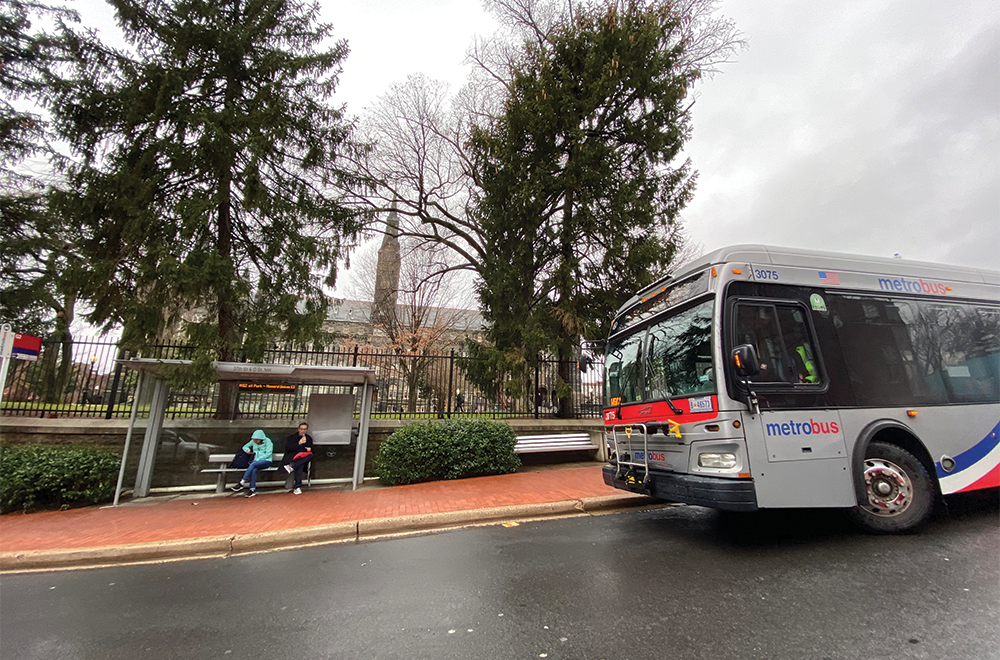Georgetown University administrators have joined students and workers in the ongoing opposition against proposed bus service changes to eliminate routes that serve the university.
University administrators testified alongside local officials and community members in opposition of proposed bus route changes at a Washington Metropolitan Area Transportation Authority public hearing Feb. 26. Residents from around Washington, D.C., packed the hearing room to express their frustrations to a panel of five WMATA officials.
The university worked with local governmental and business groups, as well as student organizations, to develop a united position opposing the proposed changes, according to Heidi Tseu, director of local government affairs at Georgetown, who testified at the hearing on behalf of the university.

“We were pleased to provide testimony last night on behalf of the University and were grateful to join with our local Advisory Neighborhood Commissioners, students and neighbors to express our shared concerns about this proposal,” Tseu wrote in an email to The Hoya.
In addition to presenting testimony at the public hearing, Georgetown also submitted a letter to WMATA on Feb. 27.
“Our historic campus is home to thousands of students and, as the District’s largest private employer, the workplace of thousands of faculty and staff. Many of our students, faculty, visitors, and staff rely on public transportation to travel to and from our campus,” the letter read.
As part of its budget proposal for the fiscal year 2021, WMATA proposed a series of service changes, including the elimination of Route D1 (Glover Park-Franklin Square Line), and the consolidation of Route G2 (P Street-LeDroit Park Line) and Route D2 (Glover Park-Dupont Circle Line), all of which serve the Georgetown neighborhood.
By consolidating the G2 and D2 lines, riders will now have to walk nearly half a mile from campus to reach a bus stop, which will make taking public transportation a less attractive option, according to the letter.
“To move access to Metrobus service even farther away – when such a ride is often just one leg of a rider’s total commute – will strongly disincentivize the use of public transportation, promote the use of single occupancy vehicles and rideshares, and increase parking and congestion in the Georgetown neighborhood,” the letter read.
A WMATA spokesperson did not respond to The Hoya’s request for comment by the time of publication.
Service changes to Route G2 will disproportionately affect campus workers — some of whom already have sizable commutes — and make their community even more inconvenient, according to Alex Taliadoros, organizing director at the Kalmanovitz Institute for Labor and the Working Poor, which develops policies and strategies to improve workers’ lives.
“We believe that about a quarter of Georgetown’s campus workers rely on the G2 for their daily commute,” Taliadoros wrote in an email to The Hoya. “ It’s not uncommon for a worker to ride a bus to their nearest Metro station, ride the train into DC, switch lines, then get off at DuPont Circle or Rosslyn to take another bus to campus. On a good day, when everything runs smoothly, their commutes last between an hour and an hour and a half. On a bad day it takes much longer.”
While the proposed changes may seem small, they will have significant detrimental impacts on Georgetown’s community members, according to Taliadoros.
“The proposed changes to the G2 route may seem small to some, but it adds a ten-minute walk each way to what is an already Odyssean journey home,” Taliadoros wrote. “It means walking an additional six blocks before-and-after a physically demanding work shift. It means waiting for a bus on a dark street corner without as much as a bus stop canopy to protect them from the elements.”
The university has encouraged community members affected by the proposed changes to submit comments via WMATA’s online survey, Tseu and Vice President for Government Relations and Community Engagement Christopher Murphy wrote in a Feb. 27 university-wide email.
The university has reposted the Georgetown University Student Association Federal and D.C. Relations Committee graphics about the routes on their social media accounts. The posts came as FedRel embarked on a social media campaign, called #WMATAWeek, to increase student awareness about the service changes.
Submitting a public comment is the best way for students to advocate for the preservation of the bus routes, according to Natalia Lopez (SFS ’22), who serves as the secretary of D.C. affairs for FedRel.
“GUSA’s Federal and D.C. Relations Committee has been working with the Local Relations Office in finding resources for students and workers on campus to advocate for their bus lines,” Lopez wrote in an email to The Hoya. “The most important outlet to comment and voice your opinion will be filling out a public comment on the WMATA website by March 2nd.”




















